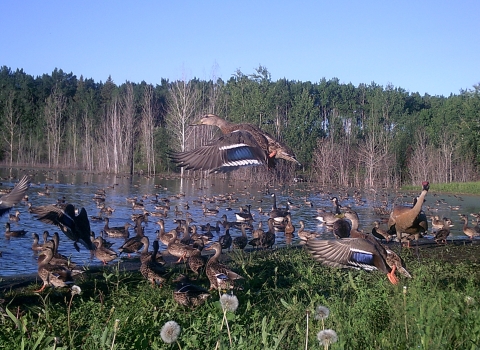Visit Us
Whether walking trails or fishing pond, the sounds and sights of the eastern woods give serenity to the soul.
Our Two Entrances:
South Tract,also known as the Dan Ashe Division, hosts 5 miles of walking trails and two scenic lakes. It is also the site of the National Wildlife Visitor Center.
National Wildlife Visitor Center hours are Wednesday through Saturday 10am to 4pm.
The Visitor Center is closed on federal holidays. The grounds are open sunrise to sunset except on Tuesdays, ST grounds will close at 4pm. Fishing and hunting is available seasonally.
North Tract offers 25 miles of trail for walking, biking, and horseback riding. With less visitation than South Tract, North Tract offers a quiet atmosphere for those seeking solitude.
North Tract will be open from 8 AM to 4 PM every Sunday.
Location and Contact Information
- Patuxent Research Refuge - South TractView Details10901 Scarlet Tanager Loop Laurel, MD 20708-4036
- Patuxent Research Refuge - North TractView Details230 Bald Eagle Drive Laurel, MD 20724
About Us
Patuxent Research Refuge was established in 1936 by executive order of President Franklin D. Roosevelt, and is the only wildlife refuge established to support wildlife research. Today the U.S. Geological Survey’s Eastern Ecological Science Center carries on the refuge’s rich tradition in scientific investigation.
Biologically, the refuge is of regional importance in that it is home to many deep-forest song birds such as the Scarlet Tanager. Patuxent’s large areas of unbroken tree cover, rare in central Maryland, allows these birds to hide from predators.
Currently, the refuge welcomes over 200,000 visitors per year and seeks to nourish their spirits as well as the wildlife of the area.
What We Do
Wildlife conservation is at the heart of the National Wildlife Refuge System. It drives everything on U.S. Fish and Wildlife Service managed lands and waters, from the purposes for which a national wildlife refuge national wildlife refuge
A national wildlife refuge is typically a contiguous area of land and water managed by the U.S. Fish and Wildlife Service for the conservation and, where appropriate, restoration of fish, wildlife and plant resources and their habitats for the benefit of present and future generations of Americans.
Learn more about national wildlife refuge is established, to the recreational activities offered, to the resource management tools used. Using conservation best practices, the Refuge System manages Service lands and waters to help ensure the survival of native wildlife species.
Our Organization
Refuge Our Organization (Programs)
Get Involved
As an organization dedicated to conserving wildlife and habitats, there are many ways for you to be involved. This could be as a volunteer, member of Friends of Patuxent, an intern, or working with the Youth Conservation Corp.
Projects and Research
The work that we conduct at the refuge focuses on understanding the needs of endangered species; developing strategies to combat climate change climate change
Climate change includes both global warming driven by human-induced emissions of greenhouse gases and the resulting large-scale shifts in weather patterns. Though there have been previous periods of climatic change, since the mid-20th century humans have had an unprecedented impact on Earth's climate system and caused change on a global scale.
Learn more about climate change impacts; and habitat management for a variety of species, including migratory birds.
On September 24, 2024, the Director of the U.S. Fish and Wildlife Service approved a Land Protection Plan (LPP) to establish an acquisition boundary for the Southern Maryland Woodlands National Wildlife Refuge. The FWS Northeast Region Division of Realty settled on a 31.38-acre parcel in Nanjemoy, Charles County, Maryland, to formally establish the refuge on December 5, 2024.
Final...


























